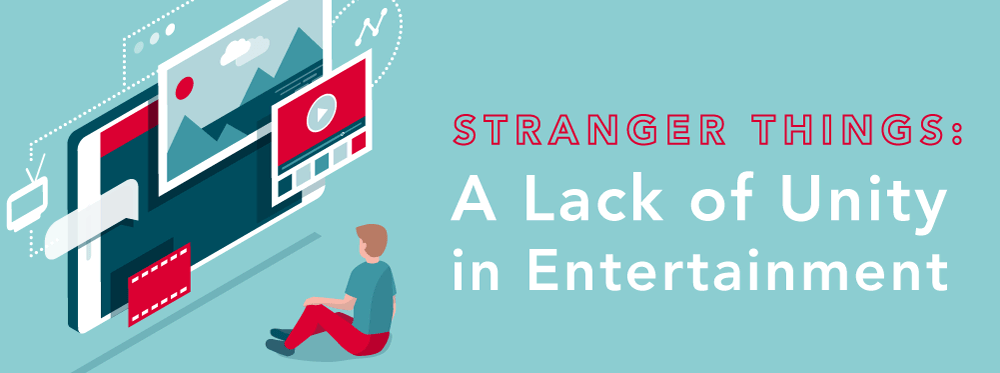Today, I spoke with a group of marketers and I asked them, “what do you think is the most popular show on Netflix this week?” The room took some time, but soon agreed on one answer: “Stranger Things.”
They were right.
I followed up my question and asked for a show of hands to see how many people had watched it?
Only 25% of the hands went up.
We have lost the sense of unified entertainment in our culture. This example is simply the tip of the iceberg into how dramatically our entertainment habits have shifted over the past few years. If only 25% of a room is watching the most-watched show on the most-subscribed entertainment platform, how much commonality is there in the rest of entertainment? I would argue that NBC’s “The Office” was the last example of a truly ubiquitous show where we can ask almost anyone in our culture about Jim and Pam and they would know.
However, it’s not just what, but also how we watch. One of our younger employees recently graduated college and moved into an apartment with two roommates. I asked him if he got cable. “No.” Does he stream content? “Yes.” What does he watch on? “My iPhone, sometimes an iPad, but almost never a TV.” Joseph and his roommates sometimes even watch three different shows, while in the same room!
This shift should force us to change the way we market to our followers. For the baby boomer generation, marketers could reference the latest episode of “I Love Lucy” and rest assured that their viewers knew the context. The same does not hold true for the average consumer of today. We must rethink the way we market to reflect this stranger time.
What do we do as marketers?
Don’t address everyone with a unified message. Since the cultural links to similar media and life experiences have fractured, we must segment and differentiate our messaging. Age is not the only (or best) way to segment; behavioral and psychographic interests provide greater ties and more reliable ways to interact.
Embrace and champion your staff’s unique background. This shouldn’t be a newsflash, but your staff has interests in many different areas. That’s why one commercial lender might say, “I’ve never been able to crack X company, while another did so with ease.” It takes coordination (and practice), but you can have a unified voice with a diversity of perspectives. Social media provides an amazing way to celebrate diverse interests and make your financial institution more approachable.
Community is Critical. The one standing way that we connect with others is through our proximity. Our hometowns. Your location and the way you engage in local events matter deeply in order to connect and engage with others. Marketing local is about showing people you are a part of the fabric of the places that matter most to them. Millennials or not, when we link sentiment and a sense of home to a market, we can have success in resonating with our audience.
More noise exists than ever before and we’ve lost some of the cultural tools to help us relate to others. But herein lies opportunity – especially in the shifting trends of entertainment consumption – to keep and hold our follower’s attention. Keep it social and be sure to maximize the diversity in our own brand to reach the niches that are important to us.


